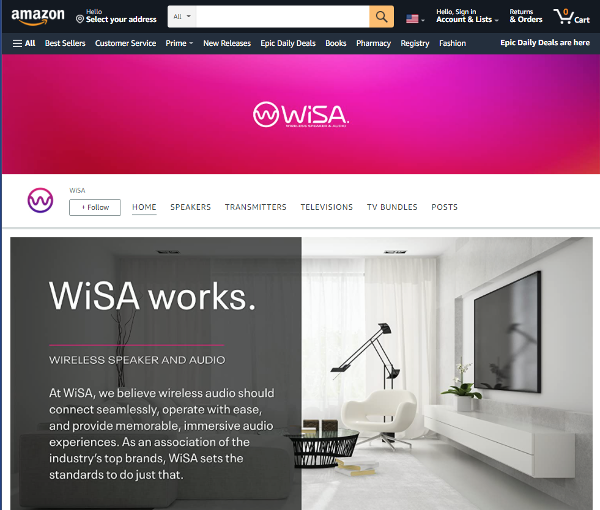WiSA: We Work to Keep Wireless Sound Simple Page 2
Ostrom: This has been a fun project. Storefronts like the one on Amazon allow consumers to see the category as a whole and see how multiple components can work together to create their ideal system. We’ve had great participation from member brands and the store is enjoying solid traffic and momentum. We are also launching a WiSA Certified Retailer program so you will soon see multiple retailers launching WiSA category pages on their websites to educate their customers on wireless home cinema and WiSA Certified products. Additionally, we continue to see rapid growth in web traffic to the WiSA Association website. The growing number of web stores and participating retailers allows us to connect in-market and show consumers where they can learn about and buy WiSA Certified products.

S&V: I noticed that not all of the WiSA-ready/certified products listed on your website are available through the store. Is that still evolving?
Ostrom: Yes, the entire process is still evolving. All of the products that were already available on Amazon are available in the store. Using our Amazon store as a showroom for WiSA Certified products allows all of the products to be featured together on one page so consumers don’t have to search for them across Amazon. Ultimately, each brand controls the availability of their products at any given retailer. Our role is to promote the category and help our member brands in any way we can with respect to their goals.
S&V: Earlier you mentioned Summit Wireless Technologies. Is Summit the original developer of technology? And what’s Summit’s relationship with WiSA today?
Ostrom: Summit Wireless Technologies is the original developer of the core wireless technology used in all WiSA Certified products and a founding member of WiSA. The WiSA Association creates the certification specifications and testing protocols used to certify products for performance and interoperability. WiSA also takes on the responsibility of working closely with member brands to grow the wireless home cinema category on a global basis. Summit founded WiSA so that there would be a separate body to create and manage certifications and member activities, as well as establish and grow the wireless home cinema category. This separation allows Summit to focus on building great technology.
S&V: What do you say to someone who is considering a wireless stereo or home theater speaker setup but reluctant to push the button, so to speak?
Ostrom: I would seek the core reason for their reluctance, knowing that the traditional barriers leading to the avoidance of wireless home cinema solutions have all been overcome. We have won the battles against low fidelity, unacceptable delay, poor connectivity, less than ideal synchronization of multiple audio channels, low number of audio channels, high total system price points, and other issues. WiSA systems perform as good, if not better, than their wired counterparts — often much better considering the majority of speakers contain their own electronics and power supplies. WiSA systems also take minutes — not hours — to set up, and are available at prices ranging from less than $1,000 to tens of thousands of dollars.
S&V: What if a potential buyer’s reluctance stems from the need to run a power cord to each speaker in a multispeaker system? How do you address that?
Ostrom: This question is more commonly asked regarding speakers located in the rear of the room than it is for subwoofers or the front left, center, and right speakers in a home theater system. In most homes, it is usually easier to find an outlet for a rear speaker than it is to run speaker wire from an amplifier or AV receiver that’s typically in the front of the room to a speaker in the back of the room. Also, a transmitter that has individual channel-level and channel-delay controls allows a speaker to be placed where it is physically convenient and then tuned based on that location. Additionally, there are many potential advantages to having each speaker contain its own unique electronics.
S&V: One final question: How far off are we from the day when speakers can be battery-powered for long periods of time, negating the need to run a power cable?
Ostrom: Battery technology is advancing and WiSA Certified speakers that offer an accessory battery pack are already available. For now, however, mid- to high-power wireless speaker systems that tend to be used for extended periods of time will need to be connected to a power source.
S&V: Is there anything else you would like to add?
Ostrom: Several facts are converging and paving the way for the wireless home cinema category. Simplicity is now a must based on consumer expectations. People are more and more comfortable accessing content through their smart devices. A significant percentage of content is delivered to the home with a multichannel soundtrack. People are spending more time at home and investing in areas that make their home a more entertaining place to be. Our goal is to help facilitate great home entertainment experiences by making it very easy for people to build a home cinema that they will enjoy for years to come.





























































